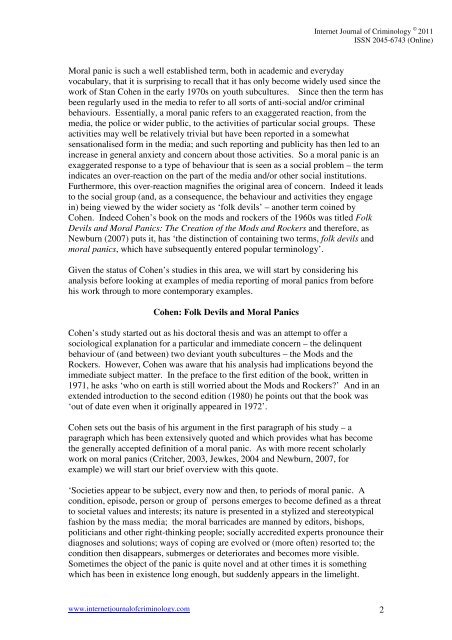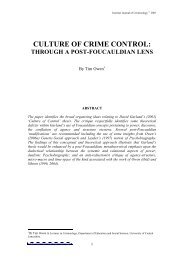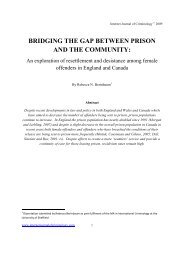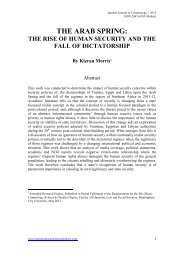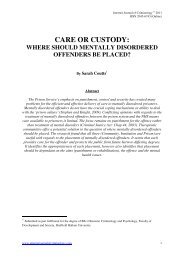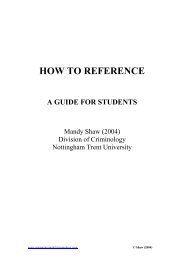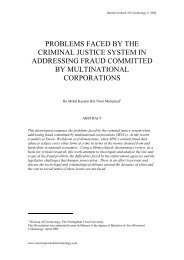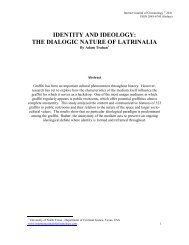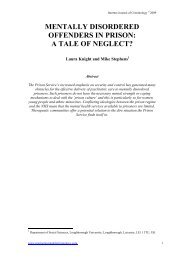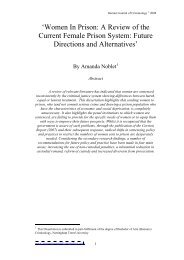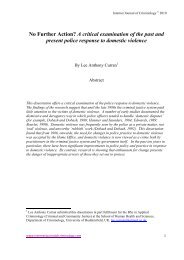moral panics and the british media - Internet Journal of Criminology
moral panics and the british media - Internet Journal of Criminology
moral panics and the british media - Internet Journal of Criminology
You also want an ePaper? Increase the reach of your titles
YUMPU automatically turns print PDFs into web optimized ePapers that Google loves.
<strong>Internet</strong> <strong>Journal</strong> <strong>of</strong> <strong>Criminology</strong> © 2011<br />
ISSN 2045-6743 (Online)<br />
Moral panic is such a well established term, both in academic <strong>and</strong> everyday<br />
vocabulary, that it is surprising to recall that it has only become widely used since <strong>the</strong><br />
work <strong>of</strong> Stan Cohen in <strong>the</strong> early 1970s on youth subcultures. Since <strong>the</strong>n <strong>the</strong> term has<br />
been regularly used in <strong>the</strong> <strong>media</strong> to refer to all sorts <strong>of</strong> anti-social <strong>and</strong>/or criminal<br />
behaviours. Essentially, a <strong>moral</strong> panic refers to an exaggerated reaction, from <strong>the</strong><br />
<strong>media</strong>, <strong>the</strong> police or wider public, to <strong>the</strong> activities <strong>of</strong> particular social groups. These<br />
activities may well be relatively trivial but have been reported in a somewhat<br />
sensationalised form in <strong>the</strong> <strong>media</strong>; <strong>and</strong> such reporting <strong>and</strong> publicity has <strong>the</strong>n led to an<br />
increase in general anxiety <strong>and</strong> concern about those activities. So a <strong>moral</strong> panic is an<br />
exaggerated response to a type <strong>of</strong> behaviour that is seen as a social problem – <strong>the</strong> term<br />
indicates an over-reaction on <strong>the</strong> part <strong>of</strong> <strong>the</strong> <strong>media</strong> <strong>and</strong>/or o<strong>the</strong>r social institutions.<br />
Fur<strong>the</strong>rmore, this over-reaction magnifies <strong>the</strong> original area <strong>of</strong> concern. Indeed it leads<br />
to <strong>the</strong> social group (<strong>and</strong>, as a consequence, <strong>the</strong> behaviour <strong>and</strong> activities <strong>the</strong>y engage<br />
in) being viewed by <strong>the</strong> wider society as ‘folk devils’ – ano<strong>the</strong>r term coined by<br />
Cohen. Indeed Cohen’s book on <strong>the</strong> mods <strong>and</strong> rockers <strong>of</strong> <strong>the</strong> 1960s was titled Folk<br />
Devils <strong>and</strong> Moral Panics: The Creation <strong>of</strong> <strong>the</strong> Mods <strong>and</strong> Rockers <strong>and</strong> <strong>the</strong>refore, as<br />
Newburn (2007) puts it, has ‘<strong>the</strong> distinction <strong>of</strong> containing two terms, folk devils <strong>and</strong><br />
<strong>moral</strong> <strong>panics</strong>, which have subsequently entered popular terminology’.<br />
Given <strong>the</strong> status <strong>of</strong> Cohen’s studies in this area, we will start by considering his<br />
analysis before looking at examples <strong>of</strong> <strong>media</strong> reporting <strong>of</strong> <strong>moral</strong> <strong>panics</strong> from before<br />
his work through to more contemporary examples.<br />
Cohen: Folk Devils <strong>and</strong> Moral Panics<br />
Cohen’s study started out as his doctoral <strong>the</strong>sis <strong>and</strong> was an attempt to <strong>of</strong>fer a<br />
sociological explanation for a particular <strong>and</strong> im<strong>media</strong>te concern – <strong>the</strong> delinquent<br />
behaviour <strong>of</strong> (<strong>and</strong> between) two deviant youth subcultures – <strong>the</strong> Mods <strong>and</strong> <strong>the</strong><br />
Rockers. However, Cohen was aware that his analysis had implications beyond <strong>the</strong><br />
im<strong>media</strong>te subject matter. In <strong>the</strong> preface to <strong>the</strong> first edition <strong>of</strong> <strong>the</strong> book, written in<br />
1971, he asks ‘who on earth is still worried about <strong>the</strong> Mods <strong>and</strong> Rockers?’ And in an<br />
extended introduction to <strong>the</strong> second edition (1980) he points out that <strong>the</strong> book was<br />
‘out <strong>of</strong> date even when it originally appeared in 1972’.<br />
Cohen sets out <strong>the</strong> basis <strong>of</strong> his argument in <strong>the</strong> first paragraph <strong>of</strong> his study – a<br />
paragraph which has been extensively quoted <strong>and</strong> which provides what has become<br />
<strong>the</strong> generally accepted definition <strong>of</strong> a <strong>moral</strong> panic. As with more recent scholarly<br />
work on <strong>moral</strong> <strong>panics</strong> (Critcher, 2003, Jewkes, 2004 <strong>and</strong> Newburn, 2007, for<br />
example) we will start our brief overview with this quote.<br />
‘Societies appear to be subject, every now <strong>and</strong> <strong>the</strong>n, to periods <strong>of</strong> <strong>moral</strong> panic. A<br />
condition, episode, person or group <strong>of</strong> persons emerges to become defined as a threat<br />
to societal values <strong>and</strong> interests; its nature is presented in a stylized <strong>and</strong> stereotypical<br />
fashion by <strong>the</strong> mass <strong>media</strong>; <strong>the</strong> <strong>moral</strong> barricades are manned by editors, bishops,<br />
politicians <strong>and</strong> o<strong>the</strong>r right-thinking people; socially accredited experts pronounce <strong>the</strong>ir<br />
diagnoses <strong>and</strong> solutions; ways <strong>of</strong> coping are evolved or (more <strong>of</strong>ten) resorted to; <strong>the</strong><br />
condition <strong>the</strong>n disappears, submerges or deteriorates <strong>and</strong> becomes more visible.<br />
Sometimes <strong>the</strong> object <strong>of</strong> <strong>the</strong> panic is quite novel <strong>and</strong> at o<strong>the</strong>r times it is something<br />
which has been in existence long enough, but suddenly appears in <strong>the</strong> limelight.<br />
www.internetjournal<strong>of</strong>criminology.com 2


